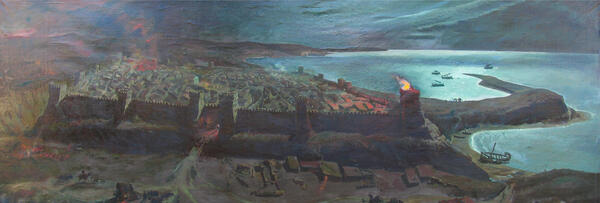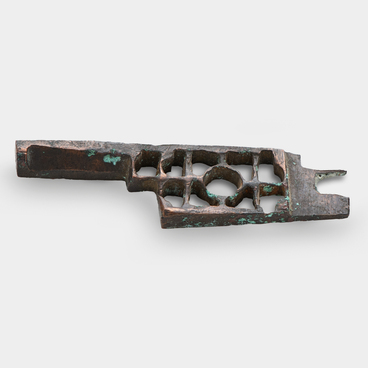The art collection of the Tanais Archaeological Museum-Reserve includes a large painting “Tanais” by Georgy Pavlovich Solonin, created in 1988.
This is a nighttime landscape with a high horizon line. In the left part of the painting, there is the ancient city on a steep coastline. The densely packed buildings with single slope roofs are surrounded by a deep moat and high fortress walls with watchtowers. In the top right corner, there is a quiet sea bay with several small ships and reflections of moonlight. Closer to the horizon, the sea almost blends in with the sky. In the foreground, there are several small buildings, wagons, people camping for the night, and the road leading to the city gate. The painting is distinguished by a muted color palette, based on dark blue and brown as well as silvery and green tones. Nowadays, it is known for certain that the central square of the Tanais citadel, depicted in the center, was actually located in the southern part of the fortress. Otherwise, according to modern archaeologists, the painting quite accurately reflects the actual location and layout of the ancient city.
Georgy Pavlovich Solonin was born on February 14,
1923, in Rostov-on-Don. In 1946, he moved to Moscow. Between 1939 and 1941, and
later, in 1946, he studied at the Mitrofan Grekov Art College. His mentor was
the famous Don painter Alexander Mikhailovich Chernykh. From 1949 to 1955,
Georgy Solonin studied at the Moscow State Art Institute named after Vasily
Surikov. There, he was influenced by prominent representatives of the post-war
Moscow school of painting. The artist mostly painted in the Lower Don Region
and the Azov Sea area. During his trips to the Don, Georgy Solonin painted
landscapes, still lifes, and genre paintings. He was also interested in the
region’s history. He depicted not only ancient cities like Tanais but also
Polovtsian statues on steppe mounds (rock figures called babas, which were
closely connected with the Cuman religious cult of shamanism), and Peter the
Great, the founder of Taganrog. In many of his works, he depicted the city of
Azov. Nowadays, the artist’s paintings and graphic works can be found in the
Museum of Contemporary Fine Arts in Rostov-on-Don, the Tanais Archaeological
Museum-Reserve, and the Azov Museum-Reserve.

